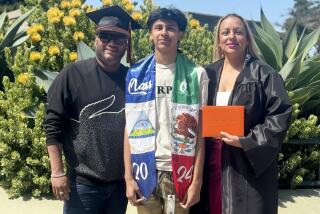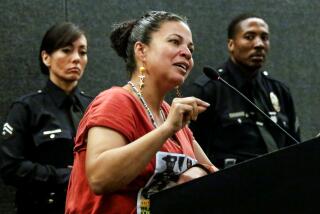Trial Ordered for Hubbard in Beach Attack : Justice: Judge finds evidence persuasive, binds over former officer on charges of attempted murder and armed robbery in assault on swimmers.
- Share via
A Municipal Court judge said Thursday that the evidence against former San Diego police Officer Henry Hubbard was considerable and ordered him to stand trial for attempted murder and attempted armed robbery in the bloody attack on three midnight swimmers on a deserted Torrey Pines State Beach.
The decision followed two days of testimony from two of the victims as well as an array of technical experts including a forensic dentist, homicide detectives and criminologists who used blood samples to place the 29-year-old officer at the scene of the summertime attack.
“I have strong suspicions that the defendant is guilty of all the charges,” Municipal Judge Ronald Domnitz told the court. He set a Nov. 6 Superior Court arraignment date for Hubbard, who is being held in lieu of $2 million in bail.
Hubbard, a lanky, mustachioed man dressed in a crisp dark-gray suit, tie and white shirt, did not show the slightest hint of emotion as the judge issued his decision.
Neither prosecutors nor defense attorney Kerry L. Steigerwalt expressed surprise afterward at the judge’s decision. But Steigerwalt had argued in court that he did not believe the prosecution’s evidence showed that the attacker intended to kill the three victims in the Aug. 15 incident.
“This assailant could have killed if he intended to kill,” Steigerwalt said. “But the evidence shows that what occurred was a sudden brawl, more of a reaction than an aggression on the part of the assailant.
“If the assailant intended to kill, why would he have said to one of the victims, as has been testified here, ‘If you want to go, you better go now’ or words to that effect? That shows there was no intent to kill.”
Hubbard, a 4 1/2-year veteran of the Police Department, has been charged with two counts of attempted murder and three counts of attempted robbery in the alleged attack on the swimmers as they dressed on the darkened state beach just south of Del Mar.
Arthur Gracia, 23, was shot once in the chest, and Aldo Ochoa, 21, was shot in the abdomen by a stocking-masked gunman after they came to the aid of a female companion, Charisma Carpenter, 21, who had been accosted by the assailant.
Hubbard, who has been fired from his police officer job, is also the prime suspect in a series of rapes and robberies that occurred during the summer at San Diego-area beaches. The rape victims included a 13- and a 14-year-old girl.
Deputy Dist. Atty. Stephen Anear, who is prosecuting the Hubbard case, would not comment on Hubbard’s suspected role in the series of attacks other than to say that the investigation is continuing.
“We’re definitely not finished with this investigation,” he said.
Anear told the court that he thought the evidence against Hubbard, which includes blood samples taken from Hubbard’s T-shirt and Bermuda shorts, was “overwhelming.”
He said the attacker stood less than 5 feet away from his victims when Gracia made a move to subdue him. “The defendant didn’t fire a warning shot. He didn’t shoot him in the leg. He shot him in the chest.
“Even a preschooler’s knowledge of anatomy would suggest that an inch or two in either direction would have killed the man.”
After shooting both the two male victims, Anear reasoned that Hubbard didn’t fire off any “finishing” shots because of a struggle that ensued over the gun.
Thursday’s testimony started on a sour note for the defense when Domnitz denied Steigerwalt’s request to subpoena Carpenter to testify, citing the guidelines of Proposition 115.
Passed by voters in June, 1990, and also known as the Crime Victim’s Justice Reform Act, the proposition sets limits on how much victims can be forced to testify in court.
“Basically, it says that the defense can’t go on any fishing expedition unless they can show that the witness will offer exonerating evidence,” Anear said. “And the judge didn’t believe that.”
On the bench, Domnitz told Hubbard and his attorney that, although Carpenter’s “statements might be different, they wouldn’t impeach” testimony that had been offered by Gracia and Ochoa.
Dr. Norman Sperber, a forensic dentist, testified that two bite marks found on Hubbard’s left shoulder were “consistent” with the clay model of Ochoa’s bite marks.
When he was arrested the night of the attack at a local hospital, Hubbard had wounds that appeared to be bite marks on his left ear and right and left shoulders, Sperber said. But, because of the elasticity of skin and the size of the other wounds, only the left shoulder was compared.
Sperber said one bite mark on Hubbard’s left shoulder consisted of two teeth imprints, and the other three teeth imprints that had “a good correlation” but didn’t match exactly with Ochoa’s clay model.
Outside the courtroom, Sperber said that odontology, the study of bite marks, was first used as evidence in court in 1975 in Los Angeles County, where a tenant bit his landlord’s nose in a murder case.
Hubbard’s defense has been that he suffered his injuries when he was attacked by three unknown assailants after his car broke down near Mira Mesa Boulevard and Interstate 805.
On Thursday, Edward Rhodes, a criminalist for the San Diego Police Department who has done research in soil analysis, testified that the dirt taken from Hubbard’s clothing and sneakers “was more consistent” with sand than samples of soil taken from the Mira Mesa Boulevard area.
A San Diego police criminalist assigned to the department’s firearms unit testified that the four casings and two spent .38-caliber bullets found at the scene were consistent with the type of ammunition the department issues to its qualified officers for off-duty use.
Patricia Aiko Lawson, another police criminalist, testified that enzyme tests, which she said gave a better fingerprint than conventional blood testing, suggested that blood thought to belong to both Gracia and Hubbard was found on the confiscated T-shirt.
Blood droplets found near a park restroom also were consistent with blood from the ex-officer’s T-shirt, she testified.
More to Read
Sign up for Essential California
The most important California stories and recommendations in your inbox every morning.
You may occasionally receive promotional content from the Los Angeles Times.














